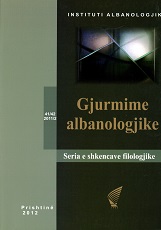NDËRTIMI I MEMORIES TEK VEPRA E KADARESË
THE CONSTRUCTION OF MEMORY AT ISMAIL KADARE’S FICTION
Author(s): Enkelena QafleshiSubject(s): Literary Texts
Published by: Instituti Albanologjik i Prishtinës
Keywords: CONSTRUCTION OF MEMORY ; ISMAIL KADARE’S FICTION ; ISMAIL KADARE
Summary/Abstract: In the article titled The Construction of Memory at Ismail Kadare’s Fiction [Ndërtimi i memories tek vepra e Kadaresë] the intentions of the author are centered round issues related to memory construction and the literary corpus to accomplish such a sort of analysis includes two novels and respectively The Three Arched Bridge and The Hankonatëve Saga. Both novels are known for a special density in mnemonic devices without which the memory could not be conceived. And as literature positions itself as equivalent of memory, what speaks out in this article really comes from the mnemonic devices employed by I. Kadare and in this course of reasoning they certainly drift anyone towards the analysis and interpretation. Hence, I revolve myself to the depicted novels aforementioned. In the article it is explicitly cited that out of a number of mnemonic devices selected to develop the narratives in The Three Arched Bridge and The Hankonatëve Saga, I have depicted out bridge and ballad of immurement as well as land associated with: shoes, mud and paranoia. Beside analyzing specifically the mnemonic devices picked out upon, I have considered also cognitive archetypes, evocations of the past, authorities featured out as characters, which in a certain manner describe the season of events they have almost happened to be involved in due to the role they have been dressed up with. And as this process is highly comes in terms with the poetic techniques of narration deployed by I. Kadare, we perceive progressively how they altogether influence the construction of memory culture, which o the other hand has veiled the whole text with a special narrative identity. In addition, the narrative style displays faithfully that textual portion identified as lectio divina - aspect of the chronicle style in the Middle Ages (Carruthers, M. 2009: 57). In pursuit to provide a short summary of the real intentions of the author herein, I could commence with the bridge as it is either a direct expression or a metaphoric dressing related to cognitive archetype it stands up for. Further more, the whole narration is based on its construction and in this manner it constitutes the basic praxis in The Three Arched Bridge. Otherwise defined as madre text – the narrative related to bridge construction, allows a variety of interpretations. And accordingly there are built up three meanings. Altogether they obviously express out the layers of meaning this cognitive archetype enjoys boastfully, and yet through meditatio analysis they still shift the attention to three models of memory which are: architectural memoriae, memoriae thesauro and arca sapientiae.
Journal: Gjurmime Albanologjike - Seria e shkencave filologjike
- Issue Year: 2011
- Issue No: 41-42
- Page Range: 369-382
- Page Count: 14
- Language: Albanian
- Content File-PDF

